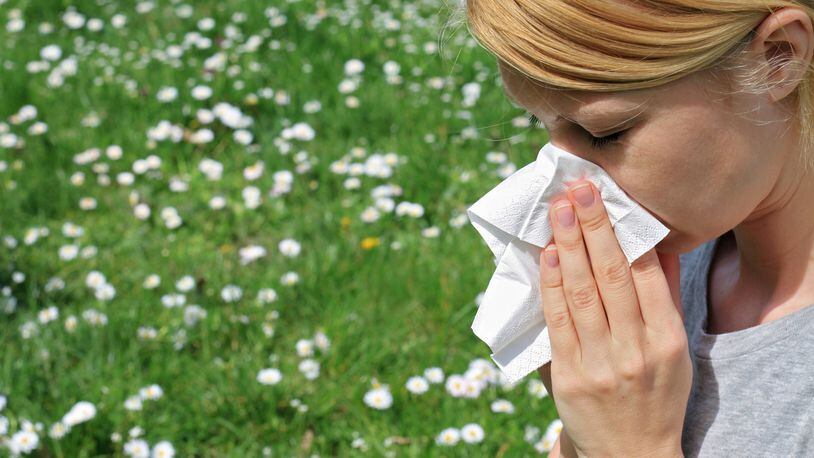“We’ve had high counts earlier this year, and overall tree pollen is high right now,” said Huxtable, who noted the first “very high” pollen day in the region occurred on Feb. 24. Spring allergies may begin as early as February and last until summer, but he said it’s unusual to see pollen counts so high so early in the season.
RELATED: Clark County sees another big spike of at least 40 overdoses in 5 days
The tree pollen is high right now but it’s not out of the ordinary for Springfield, Clark County Health Commissioner Charles Patterson said. The pollen counts have not led to many allergic reaction or upper respiratory problems.
The good news is that other pollen counts are low, including grass, he said.
“You won’t have that stacked effect,” Patterson said. “It’s give a little, take a little when it comes to that.”
The tree pollen count last week was 1,560 grains of pollen per square meter of air, higher than the 1,500 threshold for a “very high” rating. By comparison, tree pollen counts during the first two weeks of April last year ranged from 100-500, and as high as 1,000 in the spring of 2015, Huxtable said.
SOCIAL MEDIA: FOLLOW REPORTER MICHAEL COOPER ON FACEBOOK AND TWITTER.
Pollen from trees, grasses and weeds are the main cause of allergies and allergy symptoms, such as sinus headaches, irritated eyes, sneezing, coughing and congestion.
The spring allergy season in the region is typically more severe because the area has a high concentration of plants and trees that bloom simultaneously, leaving yards and sidewalks littered with pollen that triggers sniffles and sneezes.
In addition, one of the warmest winters on record sped up spring blooms this year, creating a perfect storm for allergies, according to Huxtable, who urged people suffering allergy symptoms to consult with physician or pharmacist to make sure they’re actually suffering from allergies and not another condition.
Doctors and pharmacists suggest that people suffering from allergies minimize outdoor activity when pollen counts are high, and shut windows and doors — especially overnight while they sleep — because pollen levels tend to be highest early in the morning.
“Whether it’s pollen from flowers and trees or environmental factors like mold and dust affecting allergy sufferers, the important thing is to minimize or treat the symptoms before they begin to escalate,” said Karen Mankowski, vice president of pharmacy operations for Meijer stores.
RELATED: Special Report: Healthy Springfield
When symptoms hit, the first line of defense for many allergy suffers is to use prescribed or over-the-counter sedating antihistamines.
The annual cost of allergies, including doctor visits and medication, is nearly $14.5 billion, according to the Centers for Disease Control and Prevention.
But that doesn’t include the indirect cost of allergies, such as diminished productivity from employees who are present at work but distracted by their symptoms or feeling drowsy after taking prescribed or over-the-counter medicines.
A recent study projected that the use of sedating antihistamines by workers could result in a 25 percent reduction in productivity for two weeks per year and a cost U. S. corporations as much as $2.8 billion per year.
Overall, seasonal allergies result in nearly 4 million missed or lost workdays each year, costing more than $700 million in total lost productivity, the National Academy on an Aging Society estimates.
FIVE NEWS-SUN HEALTH READS
Overdose epidemic spreads, strains Springfield first responders
Demand for, debate over Narcan soars in Springfield
Clark County to charge addicts who OD and don’t seek treatment
Clark County drug overdose deaths reach record number
Clark County leaders pledge to fight addiction stigma, OD crisis
Remedies for Fighting Allergies:
• Antihistamines: Can be taken by mouth or as a nasal spray, relieving sneezing and itching in the nose and eyes. They also reduce runny nose and, to a lesser extent, nasal stuffiness.
• Nasal Corticosteroids: These anti-inflammatory medicines can reduce all symptoms when taken regularly, and can help block allergic reactions. They are widely considered to be the most effective medication for allergic rhinitis. Combining an antihistamine with a corticosteroid appears to be more effective than either of the nasal sprays alone.
• Decongestants: Intended for short-term use, oral and nasal decongestants help decrease swelling of the nasal passages, relieving nasal stuffiness.
• Leukotriene Receptor Antagonists: Leukotriene Receptor Antagonists, such as the prescription drug montelukast (Singulair®), block the action of leukotrienes – the chemical messengers involved in allergic reactions – when taken daily.
• Natural remedies include neti pots, saline spray, honey, herbs (spirulina, eyebright and goldenseal), steam showers, spicy foods, tea and eucalyptus oil.
Source: Meijer
